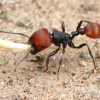11/24/2018
Earlier this year I accquired two Crematogaster queens. In the beggining it was really rough, as the queens only had 1-2 workers and no brood and the workers were dying left and right. One of the queens however laid lots of eggs and brood while the other would occasionally lay eggs, but later eat them. The queen with lots of brood mysteriously died one day(most likely due to me not realizing that the water in the test tube ran out ![]() ). The brood that the queen had produced, I gave to the other queen hoping that she would adopt the brood.and raise up some workers. At this time all her workers had died and I was uncertain about her survival. The queen proceded to eat all the brood but 2 pupae, which would later eclose into adult workers.
). The brood that the queen had produced, I gave to the other queen hoping that she would adopt the brood.and raise up some workers. At this time all her workers had died and I was uncertain about her survival. The queen proceded to eat all the brood but 2 pupae, which would later eclose into adult workers.
Now the colony has around 70 workers and about 100+ pieces of brood, with about 3-4 new worker eclosing everyday. The colony eats almost anything I give them; freeze dried crickets, Dubia roaches, and even bluegrass seeds. Because my species of Crematogaster is from the desert, they love their heat. I current have them in a home-made incubator setup, with a constant temperature at around 86-90 degrees. They are housed in a size two Antkit acrylic nest connect to a simple Tarheel Ants outworld.
Also if anybody knows what exact species this may be, let me know, I would greatly appreciate it. (Only thing I know is that they are from Southern California)
Freshly Laid Eggs:

Zoomed Out View of Brood:


Closeups of the Queen:


Edited by Derpy, January 2 2019 - 6:59 PM.


























